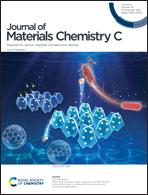Effect of electric hysteresis on fatigue behavior in antiferroelectric bulk ceramics under bipolar loading
Abstract
Antiferroelectric ceramics are exploited for applications in high energy-density capacitors due to their reversible electric-field-induced phase transitions. The difference in the fields between the forward and reverse transition is termed electric hysteresis. As accumulation of hysteresis loss is detrimental to antiferroelectric capacitors, especially in high-frequency applications, the effect of hysteresis on the long-term operation performance must be evaluated. We investigate the effect of hysteresis on fatigue behavior in two antiferroelectric ceramic compositions with comparable recoverable energy densities (0.56 vs. 0.64 J cm−3), having a large and small hysteresis of 23.9 kV cm−1 and 3.9 kV cm−1, respectively. In test cycles of 2.5 × 106 of ±60 kV cm−1 bipolar fields, the ceramic with large hysteresis exhibits a 72% decrease in the recoverable energy density and a 71% decrease in the energy efficiency. In contrast, the small hysteresis ceramic shows a 4.5% degradation in energy density and 0% degradation in energy efficiency. These results demonstrate that reducing the electric hysteresis of antiferroelectric capacitors is essential for higher energy efficiency and longer service lifetime.



 Please wait while we load your content...
Please wait while we load your content...